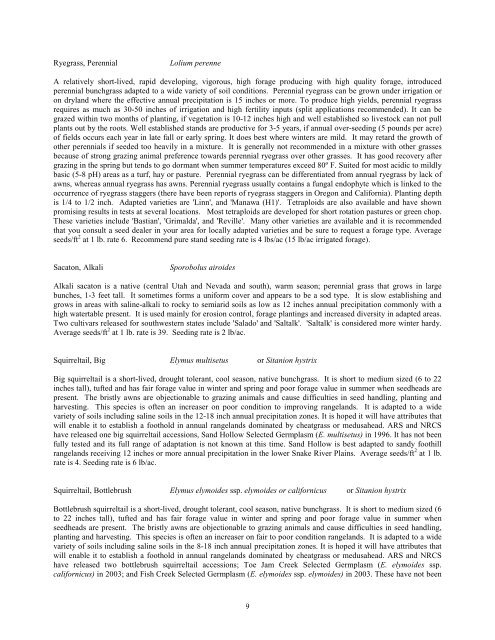Idaho Plant Materials Technical Note No. 24
Idaho Plant Materials Technical Note No. 24
Idaho Plant Materials Technical Note No. 24
Create successful ePaper yourself
Turn your PDF publications into a flip-book with our unique Google optimized e-Paper software.
Ryegrass, Perennial<br />
Lolium perenne<br />
A relatively short-lived, rapid developing, vigorous, high forage producing with high quality forage, introduced<br />
perennial bunchgrass adapted to a wide variety of soil conditions. Perennial ryegrass can be grown under irrigation or<br />
on dryland where the effective annual precipitation is 15 inches or more. To produce high yields, perennial ryegrass<br />
requires as much as 30-50 inches of irrigation and high fertility inputs (split applications recommended). It can be<br />
grazed within two months of planting, if vegetation is 10-12 inches high and well established so livestock can not pull<br />
plants out by the roots. Well established stands are productive for 3-5 years, if annual over-seeding (5 pounds per acre)<br />
of fields occurs each year in late fall or early spring. It does best where winters are mild. It may retard the growth of<br />
other perennials if seeded too heavily in a mixture. It is generally not recommended in a mixture with other grasses<br />
because of strong grazing animal preference towards perennial ryegrass over other grasses. It has good recovery after<br />
grazing in the spring but tends to go dormant when summer temperatures exceed 80º F. Suited for most acidic to mildly<br />
basic (5-8 pH) areas as a turf, hay or pasture. Perennial ryegrass can be differentiated from annual ryegrass by lack of<br />
awns, whereas annual ryegrass has awns. Perennial ryegrass usually contains a fungal endophyte which is linked to the<br />
occurrence of ryegrass staggers (there have been reports of ryegrass staggers in Oregon and California). <strong>Plant</strong>ing depth<br />
is 1/4 to 1/2 inch. Adapted varieties are 'Linn', and 'Manawa (H1)'. Tetraploids are also available and have shown<br />
promising results in tests at several locations. Most tetraploids are developed for short rotation pastures or green chop.<br />
These varieties include 'Bastian', 'Grimalda', and 'Reville'. Many other varieties are available and it is recommended<br />
that you consult a seed dealer in your area for locally adapted varieties and be sure to request a forage type. Average<br />
seeds/ft 2 at 1 lb. rate 6. Recommend pure stand seeding rate is 4 lbs/ac (15 lb/ac irrigated forage).<br />
Sacaton, Alkali<br />
Sporobolus airoides<br />
Alkali sacaton is a native (central Utah and Nevada and south), warm season; perennial grass that grows in large<br />
bunches, 1-3 feet tall. It sometimes forms a uniform cover and appears to be a sod type. It is slow establishing and<br />
grows in areas with saline-alkali to rocky to semiarid soils as low as 12 inches annual precipitation commonly with a<br />
high watertable present. It is used mainly for erosion control, forage plantings and increased diversity in adapted areas.<br />
Two cultivars released for southwestern states include 'Salado' and 'Saltalk'. 'Saltalk' is considered more winter hardy.<br />
Average seeds/ft 2 at 1 lb. rate is 39. Seeding rate is 2 lb/ac.<br />
Squirreltail, Big Elymus multisetus or Sitanion hystrix<br />
Big squirreltail is a short-lived, drought tolerant, cool season, native bunchgrass. It is short to medium sized (6 to 22<br />
inches tall), tufted and has fair forage value in winter and spring and poor forage value in summer when seedheads are<br />
present. The bristly awns are objectionable to grazing animals and cause difficulties in seed handling, planting and<br />
harvesting. This species is often an increaser on poor condition to improving rangelands. It is adapted to a wide<br />
variety of soils including saline soils in the 12-18 inch annual precipitation zones. It is hoped it will have attributes that<br />
will enable it to establish a foothold in annual rangelands dominated by cheatgrass or medusahead. ARS and NRCS<br />
have released one big squirreltail accessions, Sand Hollow Selected Germplasm (E. multisetus) in 1996. It has not been<br />
fully tested and its full range of adaptation is not known at this time. Sand Hollow is best adapted to sandy foothill<br />
rangelands receiving 12 inches or more annual precipitation in the lower Snake River Plains. Average seeds/ft 2 at 1 lb.<br />
rate is 4. Seeding rate is 6 lb/ac.<br />
Squirreltail, Bottlebrush Elymus elymoides ssp. elymoides or californicus or Sitanion hystrix<br />
Bottlebrush squirreltail is a short-lived, drought tolerant, cool season, native bunchgrass. It is short to medium sized (6<br />
to 22 inches tall), tufted and has fair forage value in winter and spring and poor forage value in summer when<br />
seedheads are present. The bristly awns are objectionable to grazing animals and cause difficulties in seed handling,<br />
planting and harvesting. This species is often an increaser on fair to poor condition rangelands. It is adapted to a wide<br />
variety of soils including saline soils in the 8-18 inch annual precipitation zones. It is hoped it will have attributes that<br />
will enable it to establish a foothold in annual rangelands dominated by cheatgrass or medusahead. ARS and NRCS<br />
have released two bottlebrush squirreltail accessions; Toe Jam Creek Selected Germplasm (E. elymoides ssp.<br />
californicus) in 2003; and Fish Creek Selected Germplasm (E. elymoides ssp. elymoides) in 2003. These have not been<br />
9
















